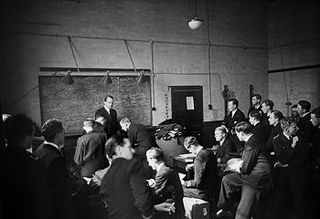Directors duties
Instructions issued for the Gunnery Division as part of the Naval Staff re-organisation as of 1921 and held by the National Archives (U.K.) included: [4] [5]
A) The Director of the Gunnery Division (D. of. G.D.) will advise on the following:
- Practical gunnery and gunnery exercises.
- The use of gas and smoke in warfare and counter-measures.
- The methods of instruction in the Training establishments for carrying out training in the use of:
- Gunnery weapons,
- Smoke, gas, anti-gas apparatus.
He is responsible for keeping the Naval Staff in touch with progress and general development of the Fleet in gunnery and chemical warfare and with the method of conducting gunnery and chemical warfare at sea.
B) He will advise on:
- Gunnery policy, both offensive & defensive as affecting design.
- Quantity and distribution of gunnery material so far as tactical requirements are concerned.
- Effect on gunnery policy of technical development and scientific research and progress.
- Air co-operation in gunnery matters.
Note.—Technical advice on the design of gunnery material, chemical warfare material, and material for counter measures is the function of the D.N.O.
C) He is responsible for scrutinising all reports of gunnery practices submitted to the Admiralty for review by Senior Officers and Cs.-in-C., and will advise as to the action necessary:—
- To control the lines on which the various commands are working, and to co-ordinate their work.
- To keep each command in touch with the progress made by others.
- To standardise methods.
D) In matters of material arising from reports of practices, he is responsible for co-ordinating suggestions from various commands and for advising on them from the point of view of practical use and Training, before they are dealt with by the appropriate Department under the Controller.
E) He is responsible for the compilation of records and summaries of Fleet gunnery practices, and for the preparation and periodical revision of the Firing Manual and any other handbook relating to his duties. He is responsible that these embody all general orders for carrying out practices necessary for the acquisition and maintenance of efficiency, and all lessons learnt from action experience and peace practices.
Notes: The responsibility for progress and development in gunnery matters in the Fleets under their command rests entirely with the various Commanders-in-Chief.
F) In conjunction with the Director of Training and Staff Duties, who is responsible for advice on policy and principles of training, he is responsible to the A.C.N.S. for the formulation of requirements of technical gunnery training.
G) He is responsible to the A.C.N.S. for advice on training in the use of gunnery weapons, smoke, gas and counter measures carried out at the Training establishments.
H) With regard to paragraphs 6 and 7, he will keep in close touch with the D.N.O, who is responsible to the Second Sea Lord for advice on complements and Quarter Bills, training in so far as it affects safe working and maintenance of material, and training in diving, and who is responsible to the Controller for advice on material.
Note.—The D. of G.D. is concerned with the use of weapons whilst the D.N.O. is concerned with their preparation for use. These respective spheres of activity meet in the drill which is required to finally prepare the weapon for use. Drill, having the double purpose of producing the best result from the weapon and also of preventing damage or accident due to improper handling of material, is common ground to both D. of G.D. and D.N.O., to whom it is therefore a joint responsibility. Whilst therefore close co-operation between the D. of G.D. and D.N.O,. is always necessary, it is especially so in the domain of drill.
I) He will be responsible for recommending the type and allocation of targets to meet the requirements of the Fleet.
Note.—Designs, repairs, and provision of targets are administered by the Controller's Department.
J). He will at all times maintain close touch with the Director of Torpedo Division respecting suggestions for the employment of new weapons, and with Director of Plans respecting the strategical aspect of all questions referred to him.
K). He will be at liberty to communicate directly with the Commanding Officers of the Gunnery schools on all questions of Training in the use of weapons lying in his sphere as defined by these instructions.
L). He will conform with paragraph 3 of the Instructions for Plans Division.



